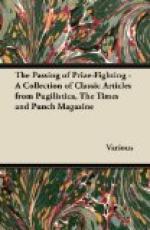feeling, the more speculative of past ages have frequently
attempted to arrive, by external means, at the immediate
possession of results otherwise requiring a long course
of intense study and anxious inquiry. From these
defunct illuminati originated the suppositionary virtues
of the magically-endowed divining wand. The simple
bending of a forked hazel twig, being the received
sign of the deep-buried well, suited admirably with
their notions of immediate information, and precluded
the unpleasant and toilsome necessity for delving
on speculation for the discovery of their desired object.
But, alas, divining rods, like dogs, have had their
day. The want of faith in the operators, or the
growth of a new and obstinate assortment of hazel
twigs, threw discredit on the mummery and the mummers.
Still the passion existed; and in no case was it more
observable than in that of the celebrated witch-finder.
An actual presence at the demoniacal rites of the
broom-riding sisterhood would have been attended with
much danger and considerable difficulty; indeed, it
has been asserted that the visitors, like those at
Almack’s, were expected to be balloted for, ticketed,
and dressed in a manner suiting the occasion.
Any infringement of these rules must have been at
the proper peril of the contumacious infringer; and
as it is more than probable some of the brooms carried
double, there was a very decent chance of the intruder’s
discovering himself across one of the heavy-tailed
and strong-backed breed, taking a trip to some distant
bourne, from whence that compulsory aerial traveller
would doubtless never have returned. Still witches
were evils; and proof of evil is what the law seeks
to enable evil’s suppression. Now and again
one of these short-cut gentry, by some railroad system
of mental calculation, discovered certain external
marks or moles that at a glance betrayed “the
secret, dark, and midnight hags;” and the witch-finding
process was instantaneously established. The
outward and visible sign of their misdeeds authorised
the further proceeding necessary for the clear proof
of their delinquencies: thus the pinchings, beatings,
starvings, trials, hangings, and burnings were made
the goal of the shortest of all imaginable short cuts;
and old women who had established pin manufactories
in the stomachs of thousands, instead of receiving
patents for their inventions, divided the honour of
illuminating the land with the blazing tar-barrels
provided for their peculiar use and benefit.
Whether it was that aerial gambols on unsaddled and
rough-backed broomsticks grew tiresome, or the small
profit attending the vocation became smaller, or that
all the elderly ladies with moles, and without anything
else, were burnt up, we can’t pretend to say;
but certain it is, the art of witchcraft fell into
disrepute. Corking, minikin, and all description
of pins, were obliged to be made in the regular way;
and cows even departed this world without the honour
of the human immolations formerly considered the necessary




